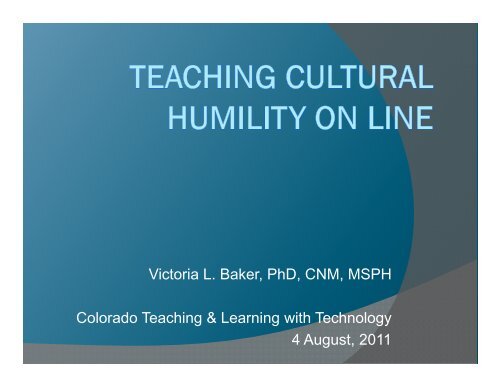Victoria L. Baker, PhD, CNM, MSPH C l d T hi &L i ithT h l Colorado ...
Victoria L. Baker, PhD, CNM, MSPH C l d T hi &L i ithT h l Colorado ...
Victoria L. Baker, PhD, CNM, MSPH C l d T hi &L i ithT h l Colorado ...
Create successful ePaper yourself
Turn your PDF publications into a flip-book with our unique Google optimized e-Paper software.
<strong>Victoria</strong> L. <strong>Baker</strong>, <strong>PhD</strong>, <strong>CNM</strong>, <strong>MSPH</strong><br />
C<strong>Colorado</strong> l d TTeac<strong>hi</strong>ng <strong>hi</strong> & LLearning i with ith TTechnology h l<br />
4 August, 2011
Learner Outcomes<br />
Apply the Process of Cultural Competence in<br />
the Delivery y of Health Care Services to<br />
teac<strong>hi</strong>ng clinical professionals cultural<br />
humility. y<br />
Apply different technologies to teac<strong>hi</strong>ng<br />
Apply different technologies to teac<strong>hi</strong>ng<br />
cultural humility on line.
So What Test<br />
Cultural Competence called for by multiple<br />
national agencies and professional associations<br />
� Diverse Population<br />
� Reduce Health Disparities<br />
� Improve Quality of Care<br />
Improve Health Outcomes
Cultural Humility?<br />
“ …not not a discrete<br />
endpoint but as a<br />
commitment and active<br />
engagement…”<br />
(Tervalon & Murray-Garcia, 1998)
Process of Cultural Competence in<br />
the Delivery of Health Care<br />
Services<br />
Skill<br />
Desire<br />
Knowledge<br />
� Encounters<br />
Awareness<br />
(Campinha-Bacote http://www.transculturalcare.net)
Teac<strong>hi</strong>ng Cultural Humility<br />
Cognitive<br />
Reflective<br />
Integrative
Teac<strong>hi</strong>ng gCultural Humility: y<br />
Cognitive Aspects<br />
�� Defining diversity<br />
� introduction page with diversity incorporated into each student’s introduction.<br />
� Discussion on definitions of diversity<br />
� Give examples (cases) and let students define diversity<br />
� RRecognizing i i organizational i i l cultures l with i h scenarios i & vocabulary b l of f a specific ifi<br />
org culture<br />
� Student to student definitions of cultures<br />
� T<strong>hi</strong>nk about similarities in discussion group<br />
� Culturally sensitive communication: quiz questions about w<strong>hi</strong>ch<br />
formulation is better.<br />
� Activities that lead them to search for information, using scenarios.<br />
Vi <strong>Victoria</strong>’s t i ’ additions dditi after ft th the session i<br />
� Online resources, e.g., game show on minority health<br />
http://familiesusa2.org/issues/minority-health/gameshow/my<br />
show/my_quiz_show.html<br />
quiz show html<br />
� Teach frameworks oF transcultural care or of culture.<br />
� Same assessment documents.
Teac<strong>hi</strong>ng gCultural Humility: y<br />
Reflective Aspects<br />
� Activities for identifying own culture and for identifying stereotyping of others<br />
�� Students interpret a story story, with enormous variation variation.<br />
� Oral, with different accents or dialects.<br />
� Written story<br />
� Photos<br />
� Present research on different treatment for different groups. (Schulman in the references.)<br />
� Student/teacher interactions as an example of cultural differences. Clarify the culture of your own<br />
class.<br />
� Written self evaluation of cultural values/beliefs. Helps clarify the role of context and beliefs.<br />
� Sharing stories of quality of care to incite cultural desire.<br />
�� From the literature<br />
� Students’personal stories.<br />
� Information literacy as an example of the importance of cultural differences.<br />
� Diversity wit<strong>hi</strong>n cultures or groups. Self reflection on your own preferences and how you feel when<br />
misidentified.<br />
� Role plays with assigned identities.<br />
� Journals. More private, allows them to express themselves in safety.<br />
� Discussion groups, important to moderate carefully.<br />
� Talk finding your voice, and the context of how it developed. Instructor must also be in the process.<br />
�� As alternative to a role play, interactive case study.<br />
<strong>Victoria</strong>’s addition after the session<br />
� YouTube video on a controversial topic, with student responses in discussion. THis one is on the use<br />
of the <strong>hi</strong>jab by some Muslim women.<br />
http://www.youtube.com/watch?v=opm1JlzDOgk&feature=related
Teac<strong>hi</strong>ng gCultural Humility: y<br />
Integrative Aspects<br />
• Discussion board on clinical rotation<br />
experiences<br />
• Videos of clinical encounters<br />
• Bl Blogging, i jjournaling li
Take Aways<br />
�� Can be done on line, with careful<br />
moderation<br />
� Practice is key. y Online to synthesize y<br />
experiences and course content.<br />
� Scenarios particular key to t<strong>hi</strong>s topic.<br />
� Instructor also in the process, reflecting.<br />
� Much more research needed<br />
� What works in practice<br />
� How to teach and assess what works.
Thanks!<br />
<strong>Victoria</strong> LL. <strong>Baker</strong> <strong>Baker</strong>, <strong>PhD</strong> <strong>PhD</strong>, <strong>CNM</strong> <strong>CNM</strong>, <strong>MSPH</strong><br />
Frontier Nursing University<br />
<strong>Baker</strong>’s <strong>Baker</strong> s Dozen Consulting<br />
malinche@wildblue.net<br />
303-704-2168


